Content for TS 23.379 Word version: 19.5.0
1…
7…
10…
10.5…
10.6…
10.6.2.3…
10.6.2.4…
10.6.2.5…
10.6.2.6…
10.6.2.9…
10.6.3…
10.7…
10.7.3…
10.7.5…
10.7.6…
10.9…
10.9.1.3.3…
10.9.1.4…
10.9.2…
10.10…
10.12…
10.19…
10.19.3…
10.19.3.1.4…
10.19.3.2…
10.19.3.2.4…
10.19.3.2.6…
A…
10.6.2.4 Group call involving groups from multiple MCPTT systems
10.6.2.4.1 Group call for non-broadcast temporary groups across multiple MCPTT systems
10.6.2.4.2 Group call for non-broadcast temporary group formed by group regroup procedure involving multiple MCPTT systems via trusted mode
10.6.2.4.3 Group call for an MCPTT group defined in the partner MCPTT system
10.6.2.4.4 Merging of groups involving multiple MCPTT systems
...
...
10.6.2.4 Group call involving groups from multiple MCPTT systems p. 64
10.6.2.4.1 Group call for non-broadcast temporary groups across multiple MCPTT systems p. 64
10.6.2.4.1.1 Group call setup p. 64
Figure 10.6.2.4.1.1.1-1 illustrates the originating side group call involving groups from multiple MCPTT systems. It considers the scenario for group hierarchies and non-broadcast temporary groups formed by group regroup. The protocol followed may be SIP.
Pre-conditions:
- The security aspects of sharing the user information between primary and partner MCPTT systems shall be governed as per the service provider agreement between them. In this case, we consider the partner MCPTT system does not share their users' information to the primary MCPTT system.
- The MCPTT user belongs to an MCPTT group hosted by the primary MCPTT system.
- A non-broadcast temporary group is formed by authorized MCPTT user/dispatcher by the group regroup procedure (subclause 10.2.4.2 in TS 23.280) and identified via a temporary MCPTT group ID.
- The affiliated MCPTT group members of the constituent MCPTT groups have been implicitly affiliated to the temporary group.
- The authorized MCPTT user/dispatcher created the temporary group on the MCPTT server of the primary MCPTT system.
- The constituent groups of the temporary group may belong to MCPTT servers of the partner MCPTT systems.
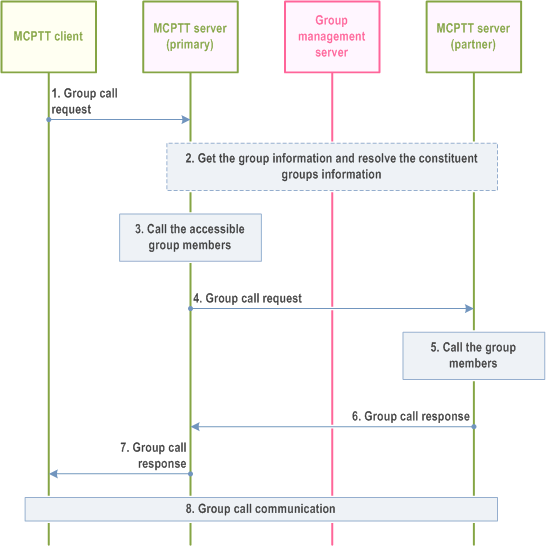
Step 1.
The affiliated MCPTT user via MCPTT client initiates a group call with an MCPTT group ID. A group call request message with the MCPTT group ID is routed to the MCPTT server of the primary MCPTT system, which owns the group and is where the authorized MCPTT user/dispatcher created the temporary group. If the group call is for a temporary group formed by the group regroup procedure, the MCPTT group ID will be a temporary MCPTT group ID.
Step 2.
The MCPTT server of the primary MCPTT system gets the group information (either from group management server or itself) including the constituent MCPTT groups' identities, accessible group members list of the constituent groups, and other related data.
Step 3.
The MCPTT server of the primary MCPTT system initiates directly a call request to the accessible group members using the detailed user information and/or location information. The group members upon receipt of the call request may accept or reject the call.
Step 4.
The MCPTT server of the primary MCPTT system may not have access to group members' information of the constituent group belonging to the partner MCPTT system. For such group members, the MCPTT server of the primary MCPTT system initiates a group call request message to the MCPTT server of the partner MCPTT system with the target group's MCPTT group ID information.
Step 5.
The MCPTT server of the partner MCPTT system further initiates a call request to the constituent group's members as described in step 3.
Step 6.
The MCPTT server of the partner MCPTT system provides a group call response to the MCPTT server of the primary MCPTT system with success or failure result and/or detailed reason information if there is a failure.
Step 7.
The MCPTT server of the primary MCPTT system provides a group call response message to the MCPTT client of the affiliated MCPTT user upon receiving responses to the call requests sent to members of primary and partner MCPTT systems. The group call response message will consist of the success or failure result and/or detailed reason information if there is a failure.
Step 8.
Upon successful call setup completion a group call is established for the group members from constituent groups of multiple MCPTT servers.
The procedure in Figure 10.6.2.4.1.1.2-1 illustrates the terminating side group call involving groups from multiple MCPTT systems. It considers the scenario for group hierarchies and non-broadcast temporary groups formed by group regroup. The protocol followed may be SIP.
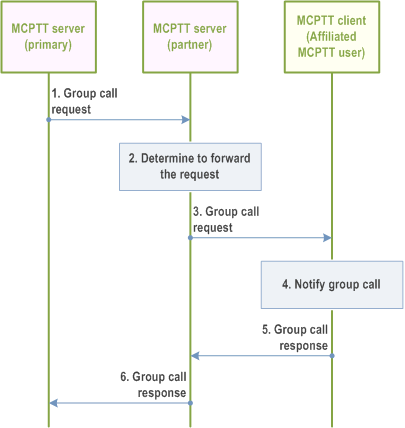
Step 1.
The MCPTT server of the primary MCPTT system sends the group call request message to the MCPTT server(s) of the partner MCPTT system.
Step 2.
The MCPTT server of the partner MCPTT system determines whether to forward the group call request message to the MCPTT client(s) based on the user affiliation.
Step 3.
The MCPTT server of the partner MCPTT system forwards the group call request message to MCPTT client(s). The MCPTT server indicates whether acknowledgement is required for the call.
Step 4.
The MCPTT user is notified about the incoming MCPTT group call.
Step 5.
The receiving MCPTT client(s) accept the group call request and a group call response message is sent to the MCPTT server of the partner MCPTT system. This response may contain an acknowledgement. The conditions for sending acknowledgement may be based on configuration.
Step 6.
The MCPTT server of the partner MCPTT system forwards the group call response message to the MCPTT server of the primary MCPTT system (i.e. group hosting MCPTT server for the group call involving groups from multiple MCPTT systems).
10.6.2.4.1.2 Group call release p. 67
The procedure focuses on the case where the group host MCPTT server releases an ongoing MCPTT group call for all the participants of that group call involving groups from multiple MCPTT systems, since at least one of the release conditions are met e.g., due to hang time expiry, last participant leaving, second last participant leaving, initiator leaving, or minimum number of affiliated MCPTT group members are not present.
Figure 10.6.2.4.1.2-1 illustrates the procedure for the MCPTT server releasing an ongoing MCPTT group call involving groups from multiple MCPTT systems.
Pre-conditions:
- The MCPTT server of the primary MCPTT system is controlling the group call involving groups from multiple MCPTT systems.
- The MCPTT client 1 belongs to group of the MCPTT server of the primary MCPTT system and the MCPTT client 2 and client 3 belong to the groups of the MCPTT server of the partner MCPTT system.
- The MCPTT users on MCPTT client 1, client 2 and client 3 are already part of the ongoing group call (e.g., as a result of group call setup involving groups from multiple MCPTT systems).
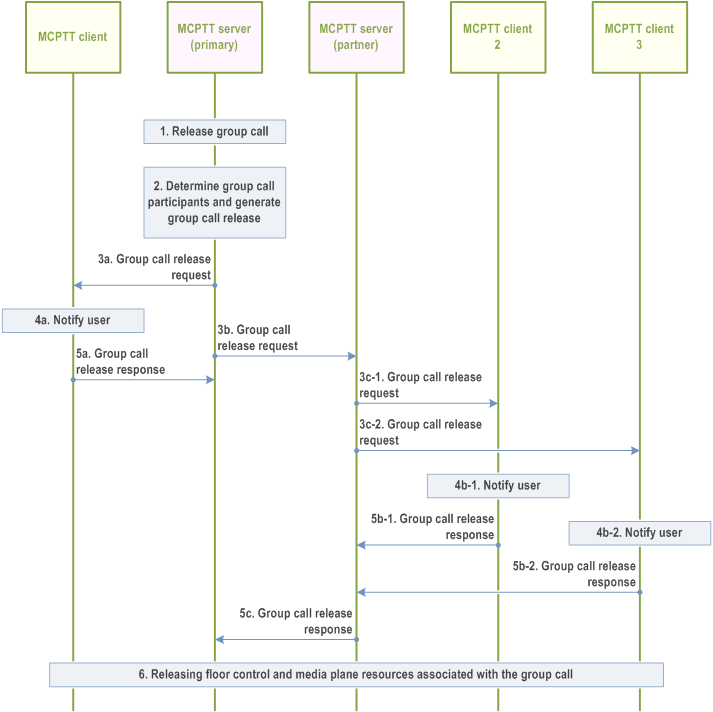
Step 1.
The MCPTT server of primary MCPTT system would like to release the MCPTT group call which is ongoing e.g., due to hang timer expiry, last participant leaving, second last participant leaving, initiator leaving, or minimum number of affiliated MCPTT group members are not present.
Step 2.
The MCPTT server of the primary MCPTT system identifies the participants of the ongoing group call and generates group call release message to release ongoing session.
Step 3.
The MCPTT server of the primary MCPTT system initiates a group call release request message via SIP core towards each accessible participant of the ongoing group call (3a). The MCPTT server of the primary MCPTT system may not have access to group members' information of the constituent group belonging to a partner MCPTT system. For such group members, the MCPTT server of the primary MCPTT system initiates a group call release request message (3b) to the MCPTT server(s) of the partner MCPTT system(s) with the target group's MCPTT group ID information. The MCPTT server(s) of the partner MCPTT system(s) further initiate group call release request messages (3c-1, 3c-2) to its group's users.
Step 4.
The MCPTT users are notified about the release of the group call.
Step 5.
The MCPTT client(s) receiving the group call release request messages provide group call release response to the MCPTT server of the primary MCPTT system. The MCPTT client(s) of the MCPTT users belonging to partner MCPTT system(s) route their responses via the MCPTT server(s) of the partner MCPTT system(s).
Step 6.
The MCPTT client 1, client 2 and client 3 have successfully released the floor control and media plane resources associated with the group call that is released.
10.6.2.4.2 Group call for non-broadcast temporary group formed by group regroup procedure involving multiple MCPTT systems via trusted mode p. 68
Figure 10.6.2.4.2-1 illustrates a group call involving a non-broadcast temporary group formed by group regroup from multiple MCPTT systems. The protocol followed may be SIP.
Pre-conditions:
- The security aspects of sharing the user information between primary and partner MCPTT systems shall be governed as per the service provider agreement between them. In this case, we consider the partner MCPTT system shares their users' information to the primary MCPTT system.
- The MCPTT user belongs to an MCPTT group hosted by the primary MCPTT system.
- A non-broadcast temporary group is formed by authorized MCPTT user/dispatcher by the group regroup procedure (subclause 10.2.4.2 in TS 23.280) and identified via a temporary MCPTT group ID.
- The MCPTT group members of the constituent MCPTT groups belonging to the temporary group are affiliated to participate in a group call for the temporary group.
- The authorized MCPTT user/dispatcher created the temporary group on the MCPTT server of the primary MCPTT system.
- The constituent groups of the temporary group may belong to MCPTT servers of the partner MCPTT systems.
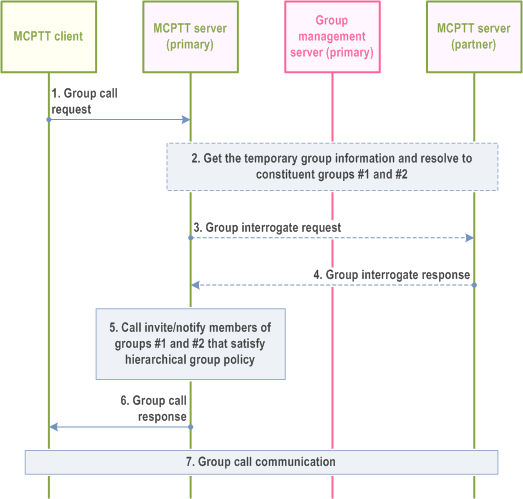
Step 1.
The affiliated MCPTT user via MCPTT client initiates a group call with an MCPTT group ID. A group call request message with the MCPTT group ID is routed to the MCPTT server of the primary MCPTT system, which owns the temporary group formed by group regroup procedure, and is also where the authorized MCPTT user/dispatcher has created the temporary group. The MCPTT group ID will be a temporary MCPTT group ID.
Step 2.
The MCPTT server of the primary MCPTT system gets the group information (either from group management server or itself) including the constituent MCPTT groups' identities, and other related data.
Step 3.
The MCPTT server of the primary MCPTT system may interrogate the MCPTT server of the partner MCPTT system for the affiliated group 2 members.
Step 4.
The MCPTT server of the partner MCPTT system responds with a list of the affiliated group members of group 2.
Step 5.
The MCPTT server of the primary MCPTT system verifies the commencement policies of the temporary group, and initiates a call invitation or call notification to the affiliated members of groups 1 and 2.
Step 6.
The MCPTT server of the primary MCPTT system provides group call response message to the MCPTT UE of authorized MCPTT user/dispatcher upon receiving responses to the call invitations sent to members of primary and partner MCPTT systems. The group call response will consist of the success or failure result and/or detailed reason information if there is a failure.
Step 7.
Upon successful call setup completion, a group call is established for the group members belonging to constituent groups of multiple MCPTT systems.
10.6.2.4.3 Group call for an MCPTT group defined in the partner MCPTT system p. 70
10.6.2.4.3.1 Pre-arranged group call setup procedure - initiating side p. 70
Figure 10.6.2.4.3.1-1 illustrates the pre-arranged group call setup procedure for an MCPTT group defined in the partner MCPTT system.
Pre-conditions:
- MCPTT group is defined on the group management server which is located in the partner MCPTT system with MCPTT users affiliated to that group.
- The members of the MCPTT group defined in partner MCPTT system belong to different MCPTT systems.
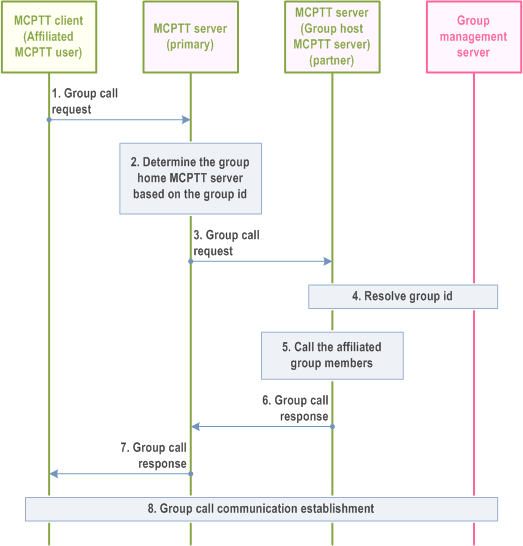
Step 1.
The affiliated MCPTT user via MCPTT client initiates a group call with an MCPTT group ID. A group call request message with the MCPTT group ID is routed to the MCPTT server of the primary MCPTT system.
Step 2.
The MCPTT server of the primary MCPTT system determines the group home MCPTT server where the MCPTT group is defined.
Step 3.
The MCPTT server of the primary MCPTT system forwards the group call request to the MCPTT server of the partner MCPTT system which owns the group and is where the authorized MCPTT user/dispatcher created the temporary group.
Step 4.
The MCPTT server of the partner MCPTT system checks whether the user of MCPTT client is authorized for initiating the group call for the selected group. If authorized, it resolves the MCPTT group ID to determine the members of that group and their affiliation status, based on the information from group management server.
Step 5.
The MCPTT server of the partner MCPTT system initiates a call request to the group's affiliated members.
Step 6.
The MCPTT server of the partner MCPTT system provides a group call response message to the MCPTT server of the primary MCPTT system of the MCPTT client. The group call response message will consist of the success or failure result and/or detailed reason information if there is a failure.
Step 7.
The MCPTT server of the primary MCPTT system forwards the group call response message to the MCPTT client.
Step 8.
Upon successful call setup completion a group call is established for the group members.
10.6.2.4.3.2 Pre-arranged group call setup - terminating side p. 71
The procedure described in Figure 10.6.2.4.3.2-1 is used for pre-arranged group call setup when acknowledgement is required from at least some of the call recipients.
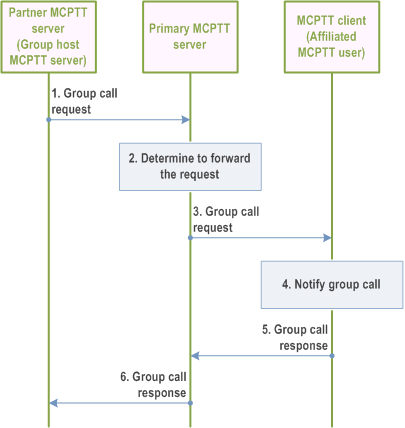
Step 1.
MCPTT server of the partner MCPTT system sends the group call request message towards the MCPTT server of the primary MCPTT system of the MCPTT client.
Step 2.
The MCPTT server of the primary MCPTT system determines whether to forward the group call request message to the MCPTT client based on the user profile.
Step 3.
The MCPTT server of the primary MCPTT system forwards the group call request message to MCPTT client. The MCPTT server indicates whether acknowledgement is required for the call.
Step 4.
MCPTT user is notified about the incoming group call.
Step 5.
The receiving MCPTT client accepts the group call and a response message is sent to the MCPTT server of the primary MCPTT system. This response may contain an acknowledgement. The conditions for sending acknowledgement may be based on configuration.
Step 6.
The MCPTT server of the primary MCPTT system forwards the response message to the MCPTT server of the partner MCPTT system (i.e. group hosting MCPTT server).
10.6.2.4.3.3 Chat group call setup p. 71
Figure 10.6.2.4.3.3-1 illustrates the group call setup procedure for an MCPTT chat group defined in the partner MCPTT system.
Pre-conditions:
- The MCPTT users of MCPTT clients 1, 2 and 3 are members of a chat group that is defined in the partner MCPTT system.
- MCPTT user 2 and MCPTT user 3 have previously joined (affiliated) to the group. MCPTT client 1, client 2, and client 3 are registered and all users (MCPTT user 1, user 2, and user 3) have been authenticated and authorized to use the MCPTT service.
- MCPTT client 1, MCPTT client 2 and MCPTT client 3 may have activated functional alias(es) configured to be used during the group call communication.
- No call is currently in progress for the group.
- Optionally the MCPTT user on MCPTT client 1 has bound a functional alias to the MCPTT group ID (TS 23.280).
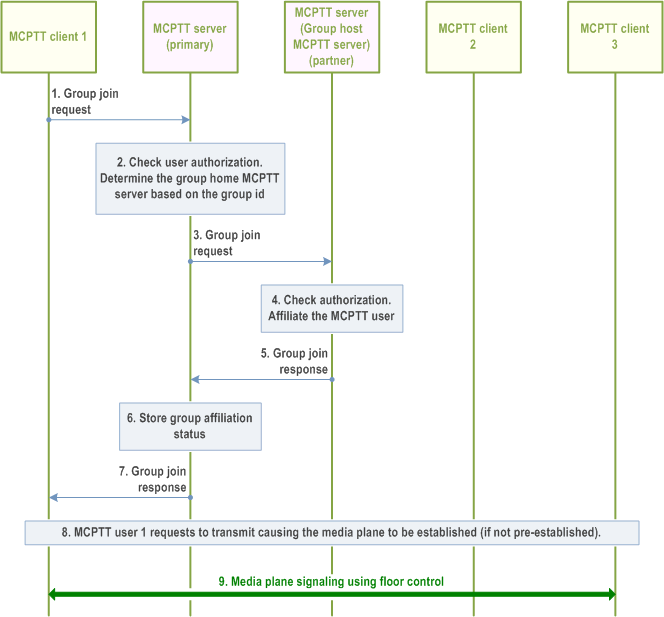
Step 1.
MCPTT client 1 sends a group join request with the MCPTT group ID of the desired group. If there is a request to transmit, then the group join request contains an indication of an implicit floor request.
Step 2.
The MCPTT server of the primary MCPTT system verifies that MCPTT user 1 is authorized to affiliate to the group by following the affiliation procedure (subclause 10.8.3.2 of TS 23.280 / subclause 10.8.3.2a of TS 23.280).The MCPTT server of the primary MCPTT system determines the group home MCPTT server where the MCPTT group is defined.
Step 3.
The MCPTT server of the primary MCPTT system forwards the group join request to the partner MCPTT server i.e. to the the group home MCPTT server.
Step 4.
The partner MCPTT server receives the group join request. The partner MCPTT server generates an implicit affiliation (if the MCPTT user 1 is not already affiliated to the group) and verifies that MCPTT user 1 is authorized to affiliate to the group by following the affiliation procedure (subclause 10.8.3 in TS 23.280).
If the functional alias is provided only in the group call request, or via binding, the MCPTT server proceeds with the value that is provided. If the functional alias is provided in both the group call request and via binding, it is up to the MCPTT server implementation to determine a value for the functional alias to be used.
If present, the MCPTT server checks whether the provided functional alias is allowed to be used and has been activated for the user.
Step 5.
The MCPTT server of the partner MCPTT system replies with a group join response indicating the acceptance of the group join request and also including the MCPTT server selected media parameters for the group call.
Step 6.
The primary MCPTT server stores the affiliation status of the user for the requested MCPTT group.
Step 7.
The primary MCPTT server forwards the group join response to the MCPTT client.
Step 8.
The MCPTT user 1 requests to transmit, causing the media plane to be established (if not already established) for the call.
Step 9.
Floor control will continue to be used by the floor participants associated with MCPTT client 1, MCPTT client 2 and MCPTT client 3 for the duration of the call. Media plane signalling using floor control will be used for subsequent calls for the group as long as one or more users are affiliated.
10.6.2.4.4 Merging of groups involving multiple MCPTT systems p. 73
Figure 10.6.2.4.4-1 below illustrates the merging of MCPTT clients in a newly formed temporary group with active group calls.
Pre-conditions:
- The temporary group consists of group 1, which is hosted by the primary MCPTT system, and group 2, which is hosted by the partner MCPTT system.
- Both group 1 and group 2 have active calls.
- The group management client of the authorized MCPTT user belongs to the primary MCPTT system.
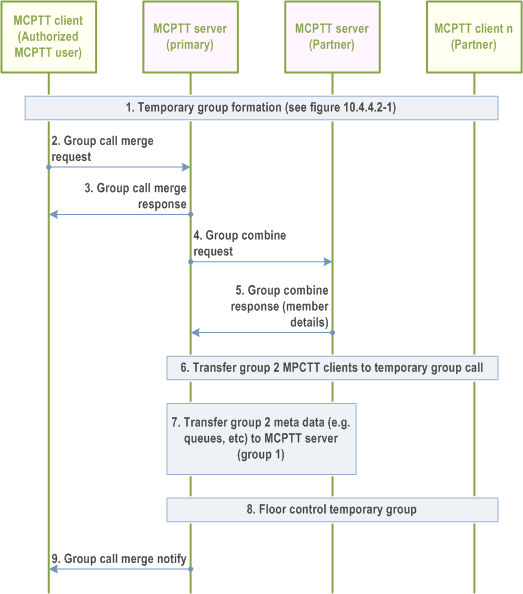
Step 1.
The temporary group formation - group regrouping involving multiple MCPTT systems, according to subclause 10.2.4.2 in TS 23.280, takes place.
Step 2.
The MCPTT client of the authorized MCPTT user requests group call merge operation to MCPTT server hosting group 1. The identities of the groups being combined are included in this message.
Step 3.
The MCPTT server (primary) responds with an OK response.
Step 4.
The MCPTT server (primary) sends a group combine request to the MCPTT server (partner) that is hosting group 2.
Step 5.
The MCPTT server (partner) responds with a list members of group 2 and an indication of which members are affiliated and which are active in the call.
Step 6.
The MCPTT server (primary) contacts the active members of group 2 inviting them to join the temporary group call.
Step 7.
The MCPTT server (partner) transfers group 2's floor status data (including pending requests and queue positions) to the primary MCPTT server and combines this with the group 1's floor status data in order to create the temporary group's floor status data.
Step 8.
The MCPTT server (primary) performs floor control for the temporary group.
Step 9.
The MCPTT server (primary) notifies the MCPTT client of the authorised MCPTT user that the active calls have been merged.